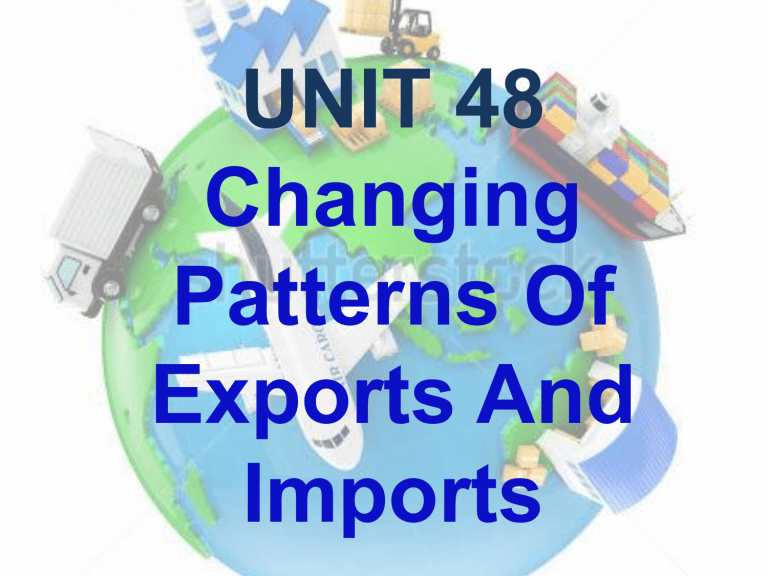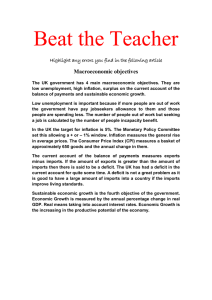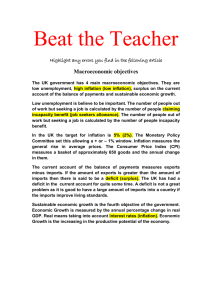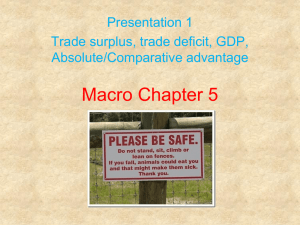Unit 48 – Changing patterns of exports and imports
advertisement

UNIT 48 Changing Patterns Of Exports And Imports Trade involves exchange of goods and services INTERNATIONAL TRADE/EXTERNAL TRADE • Exchange of goods and services between countries. • Involves risk and effort • Benefits : Allows firms to reach wider market, take greater advantage of economies of scale, source their products from wider areas and earn higher profits • Drawbacks : products travel greater distances, difficulty in communication due to different languages, differences in culture, differences in marketing strategies, trade restrictions, heavy tariffs, higher competition, differences in foreign currencies. INTERNAL TRADE • Trade within a country. • Involves risk & effort • Drawback : Reach a relatively smaller market, less advantages of economies of scale, source products from relatively narrow regions, relatively lower profits. • Benefits : contrasting to the drawbacks of international trade. The Pattern of International Trade Factors which influence the choice of trading partners of a country : • Buy from countries which produce good quality products at low prices • Sell to countries which have a high and stable demand for the products it is exporting • Most countries trade with countries close to them in : tastes development geography historical links Most of current world trade takes place between developed countries. Most of this trade is in services and high quality finished manufactured products. Changes In Exports And Imports Factors that influence the value of a country’s exports and imports: 1. Country’s inflation rate : high inflation rate will lead to more households & firms buying imports however, difficulty in exporting (opposite effect if inflation reduces) 2. Country’s exchange rate : fall in a country’s exchange rate will lower export prices and raise import prices hence increasing value of exports and decreasing amount spent on imports 3. Productivity : more productive country’s workers leads to lower labour cost per unit & cheaper the products therefore more households & firms buy more of domestic products thereby rising exports and reducing imports 4. Quality : poor the quality, lesser the exports 5. Marketing : Effectiveness of domestic firms in marketing their product influences the exports as do the imports based on the marketing skills undertaken by foreign countries. 6. Domestic GDP : If incomes rise at home more imports will be bought which could also encourage domestic demand. Could lead to a drop in exports due to switch from domestic markets to foreign markets. 7. Foreign GDP : If incomes abroad rise, foreigners will buy more products thus increasing exports. 8. Trade restrictions : Ease in trade restrictions will make it easier for firms to export Causes Of Current Account Deficit 1. Incomes at home and abroad : A deficit from a fall in incomes abroad and/or high incomes at home can be referred to as a cyclical deficit. 2. High exchange rate : It will cause export prices to rise and reduce import prices 3. Structural problems :problems with products manufactured by firms in a country, costs incurred to produce them, prices at which they are sold and marketing strategies adopted. Consequences Of A Current Account Deficit 1. May mean that a country is consuming more goods and services than it is producing sometimes referred to as a country living beyond its means. 2. Can also mean a reduction in inflationary pressure as there will be a fall in aggregate demand. 3. Output and employment is lower than possible. 4. Significance of a current account deficit depends upon the size, duration and cause. • A small deficit to last for a small period of time is unlikely to cause any problem. • A deficit caused by import of raw materials & capital goods, changes in income (domestic and abroad) or high exchange rate is self-correcting over time. • Recessions abroad may not last & with a rise in income, exports can increase. • Can put downward pressure on exchange rates (lower value) which could lead to higher exports as they become cheaper. • Deficit arising due to a lack of international competiveness is more serious as it is not self-correcting.(poor quality produced, products do not match world demand, costs of production are high). Govt. may need to intervene by introducing policies (supply-side) to improve the trade. Causes Of A Current Account Surplus 1. Low exchange rate 2. High quality of domestically produced products 3. High incomes abroad 4. Low costs of production Consequences Of A Current Account Surplus 1. 2. 3. 4. 5. Increase economy’s AD Rise in GDP Higher employment More money will enter Country is consuming fewer products than it is producing 6. If economy is operating a floating exchange rate, an increase in surplus will lead to appreciation in the exchange rate as demand for economy’s currency will exceed supply.




